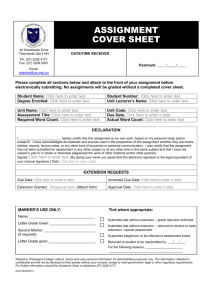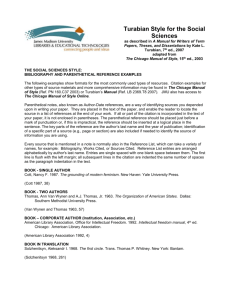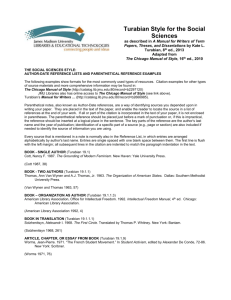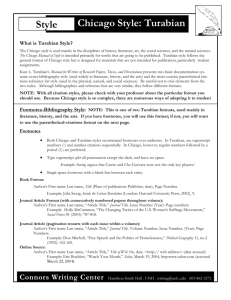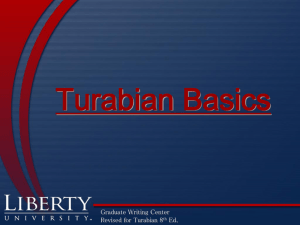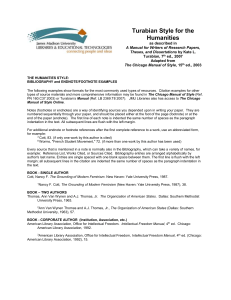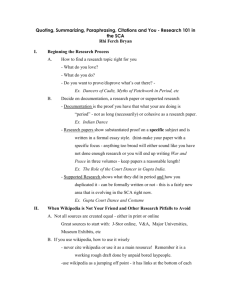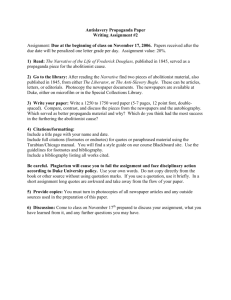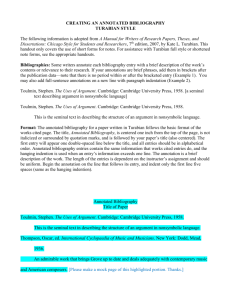Turabian Citation and Format Style Guide
advertisement
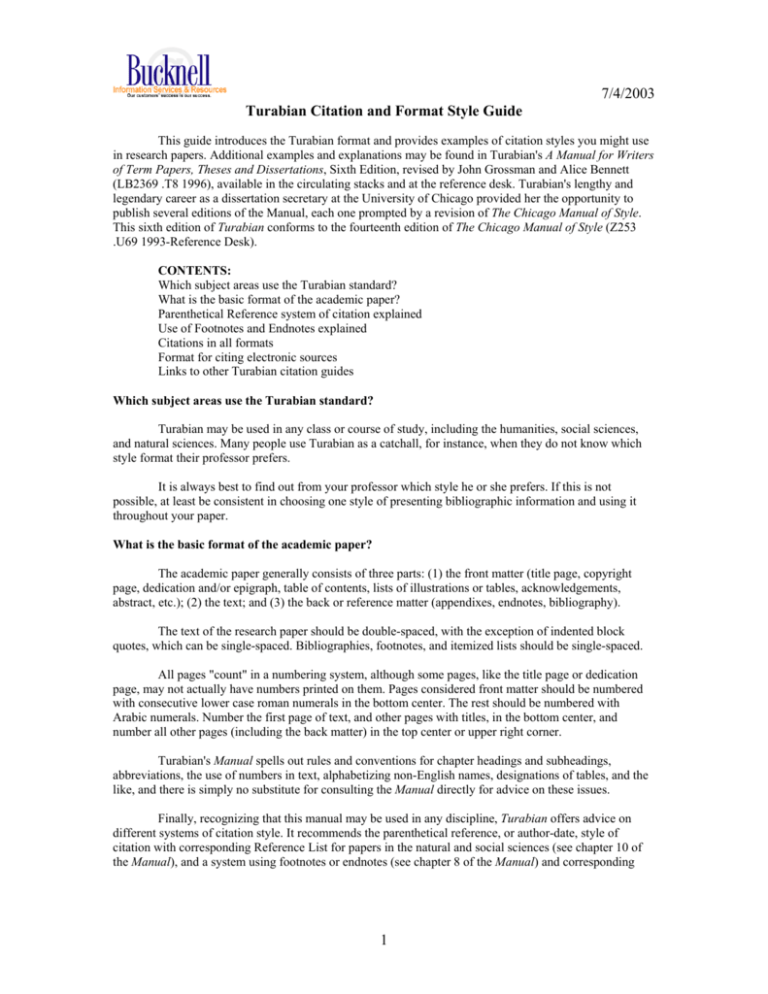
7/4/2003 Turabian Citation and Format Style Guide This guide introduces the Turabian format and provides examples of citation styles you might use in research papers. Additional examples and explanations may be found in Turabian's A Manual for Writers of Term Papers, Theses and Dissertations, Sixth Edition, revised by John Grossman and Alice Bennett (LB2369 .T8 1996), available in the circulating stacks and at the reference desk. Turabian's lengthy and legendary career as a dissertation secretary at the University of Chicago provided her the opportunity to publish several editions of the Manual, each one prompted by a revision of The Chicago Manual of Style. This sixth edition of Turabian conforms to the fourteenth edition of The Chicago Manual of Style (Z253 .U69 1993-Reference Desk). CONTENTS: Which subject areas use the Turabian standard? What is the basic format of the academic paper? Parenthetical Reference system of citation explained Use of Footnotes and Endnotes explained Citations in all formats Format for citing electronic sources Links to other Turabian citation guides Which subject areas use the Turabian standard? Turabian may be used in any class or course of study, including the humanities, social sciences, and natural sciences. Many people use Turabian as a catchall, for instance, when they do not know which style format their professor prefers. It is always best to find out from your professor which style he or she prefers. If this is not possible, at least be consistent in choosing one style of presenting bibliographic information and using it throughout your paper. What is the basic format of the academic paper? The academic paper generally consists of three parts: (1) the front matter (title page, copyright page, dedication and/or epigraph, table of contents, lists of illustrations or tables, acknowledgements, abstract, etc.); (2) the text; and (3) the back or reference matter (appendixes, endnotes, bibliography). The text of the research paper should be double-spaced, with the exception of indented block quotes, which can be single-spaced. Bibliographies, footnotes, and itemized lists should be single-spaced. All pages "count" in a numbering system, although some pages, like the title page or dedication page, may not actually have numbers printed on them. Pages considered front matter should be numbered with consecutive lower case roman numerals in the bottom center. The rest should be numbered with Arabic numerals. Number the first page of text, and other pages with titles, in the bottom center, and number all other pages (including the back matter) in the top center or upper right corner. Turabian's Manual spells out rules and conventions for chapter headings and subheadings, abbreviations, the use of numbers in text, alphabetizing non-English names, designations of tables, and the like, and there is simply no substitute for consulting the Manual directly for advice on these issues. Finally, recognizing that this manual may be used in any discipline, Turabian offers advice on different systems of citation style. It recommends the parenthetical reference, or author-date, style of citation with corresponding Reference List for papers in the natural and social sciences (see chapter 10 of the Manual), and a system using footnotes or endnotes (see chapter 8 of the Manual) and corresponding 1 7/4/2003 Bibliography (see chapter 9 of the Manual) for most papers in the humanities. (The two documentation styles are compared at chapter 11.) The style you choose should be consistent with your professor's instructions. Parenthetical reference system of citation explained Turabian recently added format advice for writers of academic papers desiring to use parenthetical references, alternately called the author-date system. Some scholars note that this citation system has now become the most widely used system, especially in the natural and social sciences. This system places, within the text of the paper, a reference to a different work within a set of parentheses. The parentheses contain the author of that referenced work (or compiler, translator, or editor), its date of publication, and a page reference, if appropriate. Each source represented by a parenthetical reference within the text must be included in the Reference List. The Reference List entry will be a complete bibliographic citation, including author, title, source, publisher, and date of publication. Turabian advices that the bibliography might be more accurately called a Selected Bibliography, Works Cited, or Sources Consulted list. Usually, it is in the form of a single, alphabetical list. It is single-spaced with one blank line between entries. The first line of each entry is flush left with subsequent lines indented five spaces. Footnotes and endnotes explained Turabian explains that the citation system using footnotes with a corresponding bibliography has long been favored in the humanities, but, with this edition, recognizes that many disciplines are abandoning it in favor of the author-date system of documentation. Notes have four basic purposes: (1) to cite authority for statements made in the text; (2) to make cross-references; (3) to amplify, qualify, or comment on material in the text that would break up the flow of the text if included there; and (4) to make acknowledgments. The first two purposes define reference notes, the last two, content notes. Note numbers should be placed in the text following the passage requiring it, in Arabic superscript (a half space above the line). In current versions of Microsoft Word, selecting “Insert,” followed by “Reference,” followed by “Footnote” will automatically set up your superscript number, as well as automatically place the footnotes in numerical order for you. Numbers should be in numerical order beginning with 1. Corresponding footnotes should be placed at the bottom of the page containing the footnote reference, separated from the text by a separator, a short line made by underscoring. Footnotes can begin with a superscript number or a regular number on the same line as the text (preferred by Turabian). If a superscript is used, there needn't be a space between it and the body of the note. If an on-line numeral is used, a period and a space should follow it. The first author's family name comes before his or her given name in a bibliography; subsequent contributing authors’ names are not inverted. When a bibliography contains several works by the same author, subsequent entries replace the author's name with an eight-space underscore followed by a period. Primacy of such entries may be determined alphabetically or chronologically. Where a single author has several types of entries, they go in this order: works written by the author as single author, works edited by author (ed.), works translated by author (trans.), works compiled by author (comp.), and then co-authored works by author. Citations in all formats The following are examples given in the Footnote/Endnote (N) format, with its corresponding Bibliography (B) entry, and the Parenthetical Reference (PR) format with its corresponding Reference List (RL) entry. Examples are based on the sixth edition of A Manual for Writers of Term Papers, Theses and 2 7/4/2003 Dissertations by Kate L. Turabian, revised by John Grossman and Alice Bennett. (LB2369 .T8 1996) [available in the circulating stacks and at the reference desk] Examples that are italicized may be underlined by those using typewriters and computer systems that cannot italicize. When italics are used, adjacent punctuation (except parentheses or brackets) must also be italicized. N = Footnote or Endnote entry B = Bibliographic list entry PR = Parenthetical Reference entry RL = Reference List entry Standard Format (example only): N 1. Author first name Author last name, Title (Location of Press: Press Name, Year Published), page number. B Author last name, Author first name. Title. Location of Press: Press Name, Year Published. PR (Author last name Year Published, page number) RL Author last name, Author first name. Year Published. Title (with only first word capitalized). Location of Press: Press Name. Note: These examples are for clarification only, and should not replace close examination of the more specific examples below, or of the Turabian text itself. I. BOOKS By a single author or editor: N 1. Richard Swinburne, The Evolution of the Soul (New York: Oxford University Press, 1997), 23. B Swinburne, Richard. The Evolution of the Soul. New York: Oxford University Press, 1997. PR (Swinburne 1997, 23) RL Swinburne, Richard. 1997. The evolution of the soul. New York: Oxford University Press. By two or three authors or editors: N 2. Joe Weixlmann and Houston A. Baker, Jr., eds. Black Feminist Criticism and Critical Theory (Greenwood, FL: Penkeville Publishing Company, 1988), 56. B Weixlmann, Joe and Houston A. Baker, Jr.. eds. Black Feminist Criticism and Critical Theory. Greenwood, FL: Penkeville Publishing Company, 1988. PR (Weixlmann and Baker, Jr. 1988, 56) RL Weixlmann, Joe and Houston A. Baker, Jr., eds. 1988. Black feminist criticism and critical theory. Greenwood, FL: Penkeville Publishing Company. By more than three authors or editors: 3 7/4/2003 N 4. Kimberle Crenshaw and others, eds., Critical Race Theory: The Key Writings that Formed the Movement (New York: New Press, 1995), 50. B Crenshaw, Kimberle, Neil Gotanda, Gary Peller, and Kendall Thomas, eds. Critical Race Theory: The Key Writings that Formed the Movement. New York: New Press, 1995. PR (Crenshaw and others 1995, 50) OR (Crenshaw et al. 1995, 50) RL Crenshaw, Kimberle, Neil Gotanda, Gary Peller, and Kendall Thomas, eds. 1995. Critical race theory: the key writings that formed the movement. New York: New Press. No author given: N 5. The Lottery (London: J. Watts, [1732]), 20-25. B The Lottery. London: J. Watts, [1732]. PR (The lottery [1732], 20-25) RL The lottery. [1732]. London: J. Watts. Note: The date enclosed in square brackets indicates that it was not found in the book itself. If no date can be ascertained, the abbreviation "n.d." standing for "no date," replaces the date. Editor or compiler as "author": N 9. Robert I. Rotberg, ed., Burma: Prospects for a Democratic Future (Cambridge, MA: The World Peace Foundation, 1998), 225. B Rotberg, Robert I., ed. Burma: Prospects for a Democratic Future. Cambridge, MA: The World Peace Foundation, 1998. PR (Rotberg 1998, 225) RL Rotberg, Robert I., ed. 1998. Burma: Prospects for a democratic future. Cambridge, MA: The World Peace Foundation. Author's work contained in author's collected works: N 11. The Standard Edition of the Complete Psychological Works of Sigmund Freud, ed. James Strachey, vol. 6, The Psychopathology of Everyday Life (London: Hogarth Press and the Institute of Psycho-Analysis, 1953), 45. B Freud, Sigmund. The Standard Edition of the Complete Psychological Works of Sigmund Freud. Edited by James Strachey. Vol. 6, The Psychopathology of Everyday Life. London: Hogarth Press and the Institute of Psycho-Analysis, 1953. PR (Freud 1953, 45) RL Freud, Sigmund. 1953. The standard edition of the complete psychological works of Sigmund Freud. Edited by James Strachey. Vol. 6, The psychopathology of everyday life. London: Hogarth Press. Note: An author's name may, but need not, be given first in a note if it is contained in the title, as in the above "N" example. Even when it is not given, the author's name must appear first in the bibliography (see 4 7/4/2003 "B" example above). In the above example, it would be permissible to give the editor's name first in the note if the paper is about the work of another person, rather than Freud. Separately titled volume in a multi-volume work with a general title and editor(s): N B 12. Gordon N. Ray, ed., An Introduction to Literature, vol. 2, The Nature of Drama, by Hubert Hefner (Boston: Houghton Mifflin, 1959), 47-49. Ray, Gordon N., ed. An Introduction to Literature. Vol. 2, The Nature of Drama, by Hubert Hefner. Boston: Houghton Mifflin, 1959. PR (Ray 1959, 47-49) OR (Hefner 1959, 47-49)* RL Ray, Gordon N., ed. 1959. An introduction to literature. Vol. 2, The nature of drama, by Hubert Hefner. Boston: Houghton Mifflin. Note: *A Reference List (RL) may also include a Cross-Reference with the name of the individual volume's author. This must be done if the second form of a parenthetical reference from above is used: Hefner, Hubert. 1959. See Ray, Gordon N., ed. 1959. Separately titled volume in a multi-volume work with a general title and one author: N 13. Sewall Wright, Evolution and the Genetics of Populations, vol. 4, Variability within and among Natural Populations (Chicago: University of Chicago Press, 1978), 67. B Wright, Sewall. Evolution and the Genetics of Populations. Vol. 4, Variability within and among Natural Populations. Chicago: University of Chicago Press, 1978. PR (Wright 1978, 67) RL Wright, Sewall. 1978. Evolution and the genetics of populations. Vol.4, Variability within and among natural populations. Chicago: University of Chicago Press. Edition other than first: N 16. Dennis Gilbert, The American Class Structure in an Age of Growing Inequality, 5th ed. (Belmont, CA: Wadsworth Publishing, 1998), 89. B Gilbert, Dennis. The American Class Structure in an Age of Growing Inequality, 5th ed. Belmont, CA: Wadsworth Publishing, 1998. PR (Gilbert 1998, 89) RL Gilbert, Dennis. 1998. The American class structure in an age of growing inequality. 5th ed. Belmont, CA: Wadsworth Publishing. Essay or chapter by one author in a work edited by another: N 24. Adrienne Rich. “Jane Eyre: The Temptations of a Motherless Woman,” in Jane Eyre: An Authoritative Text, Contexts, Criticism, ed. Richard J. Dunn (New York: Norton, 2001), 469. B Rich, Adrienne. “Jane Eyre: The Temptations of a Motherless Woman.” In Jane Eyre: An Authoritative Text, Contexts, Criticism, ed. Richard J. Dunn, 469-483. New York: Norton, 2001. 5 7/4/2003 PR (Rich 1999, 470) RL Rich, Adrienne. Jane Eyre: the temptations of a motherless woman. In Jane Eyre: an authoritative text, contexts, criticism, ed. Richard J. Dunn, 469-483. New York: Norton, 2001. II. PERIODICALS Magazine article: N 40. Alexandra Hall. “Girls with Guns,” Boston Magazine, January 2003, 7. B Hall, Alexandra. “Girls with Guns.” Boston Magazine, January 2003, 6-10. PR (Hall 2003, 8) RL Hall, Alexandra. “Girls with guns.” Boston Magazine, January 2003, 6-10. Note: If the journal is published weekly, and therefore is dated in a month, day, year format (ex: January 30th, 2003), then you must record the date of publication as day month year (without commas). Using this example, it should appear as “30 January 2003” wherever you reference the date of publication. Journal article: N 37. Andrew Feffer, “Pragmatism, Feminism, and Democracy: Rethinking the Politics of American History,” Journal of American History 89 (March 2003): 1612. B Feffer, Andrew. “Pragmatism, Feminism, and Democracy: Rethinking the Politics of American History,” Journal of American History 89 (March 2003): 1612-1615. PR (Feffer 2003, 1613) RL Feffer, Andrew. Pragmatism, feminism, and democracy: rethinking the politics of American History. Journal of American History 89: 1612-1615. Note: The issue number in a journal is needed only if it is paginated separately, rather than sequentially through the entire volume. When used, it should be preceded by the abbreviation, "no." The month or season of publication can be omitted if an issue number is given. Newspaper article, no author given: If a newspaper is cited only once or twice in a research paper, a note is sufficient documentation; newspapers are rarely cited in a bibliography or reference list. N PR 43. Irish Daily Independent (Dublin), 16 June 1904. (Irish Daily Independent [Dublin], 16 June 1904) Newspaper article, author given: N 44. Robert W. Butler, “The Everywhereness of Post-Modernism: Whatever it is, PostModernism Riddles our Self-Conscious Acts.” Kansas City Star, 19 April 2003, I4. PR (Butler, 19 April 2003, I4) 6 7/4/2003 Note: If a newspaper is cited repeatedly, covering a range of dates, group them in a bibliography or reference list using only one entry. Below are two different examples in the two list formats: B New York Times. 27 February -16 June 1998. RL Saturday Review. 1996. 2, 16, 30 July; 8, 22, 27 August. Book review in a journal: N Jan Hogendorn, "Competing for Cotton," review of Two Worlds of Cotton: Colonialism and the Regional Economy in the French Soudan, 1800-1946, by Richard L. Roberts, Journal of African History 39 (1998): 333. B Hogendorn, Jan. "Competing for Cotton," review of Two Worlds of Cotton: Colonialism and the Regional Economy in the French Soudan, 1800-1946, by Richard L. Roberts. Journal of African History 39 (1998): 333-34. PR (Hogendorn 1998, 333) RL Hogendorn, Jan. 1998. "Competing for cotton," review of Two worlds of cotton: Colonialism and the regional economy in the French Soudan, 1800-1946, by Richard L. Roberts. Journal of African History 39: 333-34. Note: A book review does not always carry its own title, and sometimes the name of the reviewer is not mentioned. An entry might begin, therefore, "Review of . . . " In that case, it is alphabetized in all lists under "Review." N 45. Paula Boxie, review of Dancing at the Louvre: Faith Ringgold's French Collection and Other Story Quilts, by Dan Cameron and others, The Western Journal of Black Studies 22 (Spring 1998): 72. B Boxie, Paula. Review of Dancing at the Louvre: Faith Ringgold's French Collection and Other Story Quilts, by Dan Cameron and others. The Western Journal of Black Studies 22 (Spring 1998): 72. PR (Boxie 1998, 72) RL Boxie, Paula. Dancing at the Louvre: Faith Ringgold's French collection and other story quilts, by Dan Cameron and others, The Western Journal of Black Studies 22 (Spring 1998): 72. III. REFERENCE WORKS: ENCYCLOPEDIA, DICTIONARY, AND ATLAS ENTRIES Encyclopedia, dictionary, and atlas citations generally omit all facts of publication except the edition and date. Turabian's 6th edition explains that well-known reference books are generally not listed in bibliographies. Should you wish to do so, simply adapt the note references below. References to an alphabetically arranged work like a dictionary or encyclopedia use the abbreviation "s.v.," standing for "sub verso" ("under the word"); there is no need to use a page number. Signed article: N PR 1. Morris Jastrow, "Nebo," in Encyclopaedia Britannica, 11th ed. (Morris Jastrow, "Nebo," in Encyclopaedia Britannica, 11th ed.) Unsigned article: 7 7/4/2003 N PR 2. Encyclopedia Americana, 1963 ed., s.v. "Sitting Bull." (Encyclopedia Americana, 1963 ed., s.v. "Sitting Bull") IV. GOVERNMENT DOCUMENTS AND TECHNICAL REPORTS Government document: N 50. U.S. House of Representatives, Ninety-fifth Congress, second session. Investigation of the Assassination of President John F. Kennedy. (Washington, D.C., 1978), 16. B U.S. House of Representatives, Ninety-fifth Congress, second session. Investigation of the Assassination of President John F. Kennedy. Washington, D.C., 1978. PR (U.S. House of Representatives 1978, 16). RL U.S. House of Representatives. Ninety-fifth Congress, second session. 1978. Investigation of the Assassination of President John F. Kennedy. Washington, D.C. Note: You may record the publishers' information in any one of the following formats, as long as you choose one and use it consistently for government publications throughout the paper: Washington, D.C.: U.S. Government Printing Office, 1985. Washington, D.C.: Government Printing Office, 1985. Washington, D.C.: GPO, 1985. Washington, D.C., 1985. Washington, 1985. Technical report--Educational Resources Information Center (ERIC) document: N 62. Robson, Barbara, The Cubans: Their History and Culture (Washington , D.C.: Center For Applied Linguistics, Refugee Service Center, 1996), 22, ERIC, ED 398322. B Robson, Barbara. The Cubans: Their History and Culture. Washington , D.C.: Center for Applied Linguistics, Refugee Service Center, 1996. ERIC, ED 398322. PR (Robson 1996, 22). RL Robson, Barbara. 1996. The Cubans: Their history and culture. Washington , D.C.: Center for Applied Linguistics, Refugee Service Center. ERIC, ED 398322. V. SECOND OR SUBSEQUENT CITATIONS IN NOTES If you use the notes/bibliography style of referencing sources, only the first note reference to a source needs to be complete. Subsequent references should be shortened. If the first reference is this: 1. Max Plowman, An Introduction to the Study of Blake (London: Gollancz, 1982), 32. The next reference to the same page, with no intervening references, would be: 2. Ibid. The next reference to a different page, with no intervening reference, is: 8 7/4/2003 3. Ibid., 68. A subsequent reference where there has been an intervening reference would be: 6. Plowman, 68. With an intervening reference and more than one title by the author, give author's surname, a brief title, and page number: 6. Plowman, Study of Blake, 125. VI. ANNOTATED BIBLIOGRAPHIES Annotations need not be in complete sentences, though they begin with a capital and end with a period. They begin on the line following the bibliographic information, and should be indented five spaces. Thompson, Oscar, ed. International Cyclopaedia of Music and Musicians. New York: Dodd, Mead, 1936. An admirable work that brings Grove up to date and deals adequately with contemporary music and American composers. VII. FORMAT FOR CITING ELECTRONIC SOURCES Citations of electronic documents can take the same basic form as citations of paper materials. However, since online sources may be updated or modified continually, the date you access the information is very important to include. As with all citations, the goal is to give authors the credit they deserve and to provide enough information to enable the items to be retrieved again, either by you or by someone else. Turabian offers some guidance on the citation of electronic sources at 8.141, though this guidance falls short of covering the variety of electronic documents you may encounter. Nevertheless, the critical information to include is: Author/editor; Title; name and description of the source (e.g., whether CDROM, online source, diskette); city of publication if ascertainable; publisher, vendor, or both; date of publication, access, or both; and identifying numbers or pathways to access the material (e.g., a URL). For Internet sources, you normally will not be able to supply a page number reference, as pagination will differ from machine to machine, depending on the settings of your browser. Try to supply some reference for where in the document the cited material occurs, such as a heading or subheading inherent in the document. World Wide Web sites in general: N 22. NAACP, "Legal Affairs," NAACP Online [home page on-line]; available from http://www.naacp.org/programs/legal.html; Internet; accessed 3 May 1999. B NAACP. "Legal Affairs," NAACP Online. Home page on-line. Available from http://www.naacp.org/programs/legal.html; Internet; accessed 3 May 1999. PR (NAACP 1999). RL NAACP. 1999. "Legal affairs," NAACP online. Home page on-line. Available from http://www.naacp.org/programs/legal.html; Internet. On-Line Periodical from Commercial Database with print counterpart: 9 7/4/2003 N 3. Maura I. Strassberg, "Distinctions of Form or Substance: Monogamy, Polygamy and Same-Sex Marriage," 75 N.C. L. Rev. 1501, 1507 (1997) [journal on-line]; available from LexisNexis Academic Universe, Law Reviews, <http://web.lexis-nexis.com/universe> (accessed 4 February 1999) (part 1 of 2). B Strassberg, Maura I. "Distinctions of Form or Substance: Monogamy, Polygamy and Same-Sex Marriage." 75 N.C. L. Rev. 1501 (1997) [journal on-line]; available from Lexis-Nexis Academic Universe, Law Reviews, <http://web.lexis-nexis.com/universe> (accessed 4 February 1999). PR (Strassberg 1997, 1507) RL Strassberg, Maura I. 1997. Distinctions of form or substance: Monogamy, polygamy and same-sex marriage. 75 N.C. L. Rev. 1501 [journal on-line]; available from Lexis-Nexis Academic Universe, Law Reviews, <http://web.lexis-nexis.com/universe> (accessed 4 February 1999). N 12. Mason Stokes, "Someone's in the Garden with Eve: Race, Religion, and the American Fall," American Quarterly 50, no. 4 (1998): 724, available from Project Muse, <http://muse.jhu.edu/journals/american_quarterly/v050/50.4stokes.html> (accessed 11 February 1999). B Stokes, Mason. "Someone's in the Garden with Eve: Race, Religion, and the American Fall." American Quarterly 50, no. 4 (1998): 718-744, available from Project Muse, <http://muse.jhu.edu/journals/american_quarterly/v050/50.4stokes.html> (accessed 11 February 1999). PR (Stokes 1998, 724) RL Stokes, Mason. 1998. Someone's in the garden with Eve: Race, religion, and the American fall. American Quarterly 50, no. 4: 718-744, available from Project Muse, <http://muse.jhu.edu/journals/american_quarterly/v050/50.4stokes.html> (accessed 11 February 1999). Electronic Journal (E-Journal): N 7. Tessa Bartholomeusz, "In Defense of Dharma: Just-War Ideology in Buddhist Sri Lanka,"Journal of Buddhist Ethics 6 (1999), [e-journal] <http://jbe.la.psu.edu/6/bartho991.htm> (accessed 15 February 1999). B Bartholomeusz, Tessa. "In Defense of Dharma: Just-War Ideology in Buddhist Sri Lanka,” Journal of Buddhist Ethics 6 (1999). [e-journal] http://jbe.la.psu.edu/6/bartho991.html (accessed 15 February 1999). PR (Bartholomeusz 1999) RL Bartholomeusz, Tessa. 1999. In defense of Dharma: Just-war ideology in Buddhist Sri Lanka," Journal of Buddhist Ethics 6. [e-journal] <http://jbe.la.psu.edu/6/bartho991.htm> Electronic mail (E-mail): Turabian offers no guidance for citing e-mail. One approach would be to treat it like personal correspondence, identifying the author and the correspondent, title (if any), subject description, and date, much like you would other unpublished material. Whether an e-mail communication should be noted in a bibliography is an open question. If you decide to do so, adapt the following consistent with conventions cited herein. 10 7/4/2003 A text reference to an e-mail communication might look like this: Some suggest that analysis of child maltreatment in Pennsylvania should be carried out on disaggregated data (R.W. Wilson, personal communication, March 24, 1999). A foot- or end-note entry for the above may look like this: 56. R.W. Wilson to J.T. Berry,* March 24, 1999, "Child Maltreatment Research," personal e-mail. Note: You may give the author's e-mail address at the * in angle brackets. If the date of access is different from the date of publication, put it in parentheses at the end of the note CD-ROM: N 1. Jeffrey Michael Jones, "A Survey of the Use of Household Appliances in MiddleClass American Homes, 1925-1960" (Ph.D. diss., University of Chicago, 1995), abstract in Dissertation Abstracts International 55 (1995): 3578A, Dissertation Abstracts Ondisc [CDROM], November 1995. B Jones, Jeffrey Michael. "A Survey of the Use of Household Appliances in Middle-Class American Homes, 1925-1960." Ph.D. diss., University of Chicago, 1995. Abstract in Dissertation Abstracts International 55 (1995): 3578A, Dissertation Abstracts Ondisc [CD-ROM], November 1995. PR (Jones 1995) RL Jones, Jeffrey Michael. 1995. A survey of the use of household appliances in middle-class American homes, 1925-1960. Ph.D. diss., University of Chicago. Abstract in Dissertation Abstracts International 55: 3578A, Dissertation Abstracts Ondisc [CD-ROM], November 1995. N 2. Oxford English Dictionary, 2d ed., s.v. "glossolalia" [CD-ROM] (Oxford: Oxford University Press, 1992). B Oxford English Dictionary, 2d ed., s.v. "glossolalia" [CD-ROM] (Oxford: Oxford University Press, 1992). PR (Oxford English Dictionary, 1992). RL Oxford English Dictionary, 2d ed., 1992. s.v. "glossolalia" [CD-ROM] (Oxford: Oxford University Press, 1992). Links to other Turabian citation guides Andrew Harnack and Eugene Kleppinger have put online portions of their book Online! A Reference Guide to Using Internet Resources, (http://www.smpcollege.com/online-4styles~help/cite7.html), including a section on citations in the Chicago Manual of Style format (same as Turabian). This source is especially useful because it adapts Chicago/Turabian formats to Internet sources that those books do not themselves cover. A nice style guide from the Ithaca College Library (http://www.ithaca.edu/library/course/turabian.html) adapts Turabian rules to a small but oft-used sample of citation types in the footnote/bibliography style. 11 7/4/2003 A concise style sheet of Turabian style, giving citations in bibliography format (first section), and footnote format (last section), was developed by the University Libraries of The University of Southern Mississippi (http://www.lib.usm.edu/~facbib/Guides/turabian.html). 12

